
Return to 1998 SPRING Index
![]()
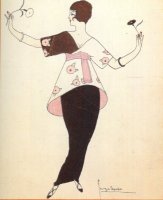 Georges Lepape. Illustration of Poiret Dress. Victoria and Albert Museum
Georges Lepape. Illustration of Poiret Dress. Victoria and Albert Museum
Over the course of the century, the Fashion Photographer has metamorphosed from society portraitist into media celebrity. The top Photographers wield immense influence and power in the multi-billion pound world of fashion. Although the photographers and their images may have changed, Fashion Photography remains based on the fact that something can be more beautiful in a photograph than in real life.
Fashion photography is not simply a form of news photography. Successful pictures do far more than simply record the clothes. They capture the zeitgeist and help to dictate what is desirable.
The evolution of fashion photography is inextricably linked with the development of photographic techniques, printing and the fashion industry itself. Until the Industrial revolution and the invention of the sewing machine, fashion was exclusively for the wealthy. It was not until the end of the nineteenth century that it began to reach a wider audience. Along with the emergence of the bourgeoisie came couturiers and fashion magazines. Charles Worth is credited as the very first couturier and was responsible for the idea of using live, moving models to show his clothes. The first illustrated fashion magazine, Vogue, was launched in 1892 providing the medium through which fashion photography could develop.
 Meyer. Ann Andrews photographed by Baron Adolphe de Meyer, 1919. American
Vogue
Meyer. Ann Andrews photographed by Baron Adolphe de Meyer, 1919. American
Vogue
Originally, illustrators such as Christian Berard and Georges Lepape provided the images. Couturiers were initially distrustful of photographers, concerned about plagiarism at a time when exclusivity rather than publicity drove the fashion industry.
The first fashion photographer was probably Baron Adolphe de Meyer who was hired by Conde Nast in 1913 to take experimental pictures for Vogue. Early fashion pictures were essentially society photographs of aristocrats, actresses and society models wearing their own clothes.
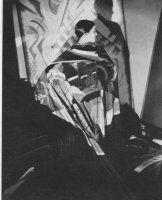 Edward Steichen for American Vogue, 1925. American Vogue
Edward Steichen for American Vogue, 1925. American Vogue
It was not until the 1920's that photography began to replace illustration. Photographic imagery and ideals of feminine beauty were heavily influenced by the movie industry. Work was studio based as location photography was not practicable. The clothes themselves were usually from Paris and the couture gowns were indicative of the fact that fashion was still very exclusive. The relationships between Photography, Painting and Art were being explored and established. Some felt that fashion photography was a capitulation to commercialism and somehow not real photography. Edward Steichen, who joined Vogue in 1923, trained as an artist but symbolically destroyed all his canvases in 1918 to concentrate on photography Photographers such as George Hoyningen-Huene were more influenced by Art Deco and the Bauhaus than by Haute Couture. In these pioneer days, photographers were given a free hand and competition between the magazines Vogue and Harpers Bazaar encouraged creativity.
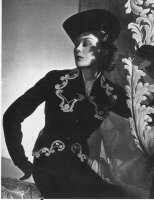 1930's Schiaperelli suit by Horst P Horst. Hamiltons Photographers Ltd
1930's Schiaperelli suit by Horst P Horst. Hamiltons Photographers Ltd
By the 1930's fashion photography had become a distinctive visual genre in the Arts. Couture was still for the aristocratic but fashion itself was beginning to become less elite. Vogue had become an important arbiter of fashion, purveying elegant and tasteful images to its affluent readers who had the time, money and dedication to be well dressed. Development of hand held cameras and faster film speeds (Particularly the 1/1000 Leica) made outdoor shoots feasible. The Rolliflex camera and colour film provided new levels of reality. Images by sport's photographer Martin Munkaacsi and by the American Fresh Air School captured the new interest in outdoor activities such as swimming and golf. These vibrant, sporty images ran side by side with the more traditional Grand Dame studio photographs. The Surrealism Art movement had a huge influence and there was a marked shift from classicism to surrealism. Photographs by Man Ray and Horst P. Horst provided a fusion of contemporary art and fashion.
World War II effectively closed down the fashion industry. Paris became isolated by the French Occupation in 1940 and photographers such as Man Ray and Horst P. Horst emigrated to New York. The shift from Europe to the U.S.A. was coupled with the emergence of a youthful and sporty American look.
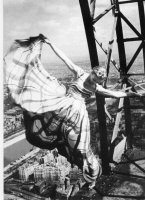 Sur La Tour Eifel by Erwin Blumenfeld, 1938
Sur La Tour Eifel by Erwin Blumenfeld, 1938
Readership of magazines soared during the war. Fashion became more practical and realistic, rationing forcing everyone to make-do and mend. Erwin Blumenfeld pioneered use of the new Hasselblad camera, the wide-angle lens providing new opportunities in perspective and composition. Irvin Penn set new standards with exquisite, elegant images. 1947 saw a revolution with the introduction of Christian Dior's New Look. Austere utility clothes were replaced by extravagant and feminine ensembles. Public demand was instantaneous and the New Look quickly became a post war symbol of youth, hope and the future. Glamour had returned.
The 1950's saw huge changes in society and the role of fashion. Years of deprivation and rationing fuelled a new consumerism. A booming ready to wear industry facilitated a huge shift from elitism to mass market appeal. Fashions from Paris were transmitted to the general public through the medium of magazines. Photographers such as Clifford Coffin, who adapted the dentists Ring Light for fashion photography, covered the Paris Collections. Newspapers also began to feature fashion. Models were beginning to attain celebrity status as icons of beauty.
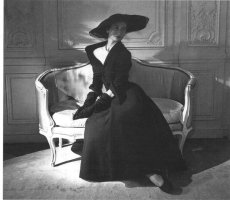 Dior's New Look, 1947. Association Willy Maywald
Dior's New Look, 1947. Association Willy Maywald
New, young photographers were vital. Injecting energy and redefining the acceptable boundaries of taste and nudity. Richard Avedon pioneered a semi documentary style, a shoot with a story. Irwing Penn's strong, graphic images were instantly recognisable, often shot against a white background. Norman Parkinson's career flourished, his natural and witty images having timeless appeal.
Bert Sterns lavish lifestyle and photographs of women as sex objects heralded the 1960's and the growing New York Art scene.
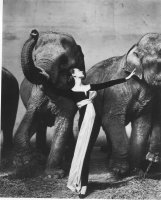 Dovima with Elephants,1955 by Richard Avedon
Dovima with Elephants,1955 by Richard Avedon
The 1960's were years of major change in fashion and fashion photography. As Bob Richardson observed “Sex…happened to fashion photography in the 1960's”. Women's roles in society were being questioned and the youth quake was having an enormous cultural influence. Fashion trends were not just flowing down from Paris but were coming up from street culture. In Britain the terrible three David Bailey, Terence Donovan and Bob Richardson were instrumental in introducing spontaneity and sex into fashion photography. The development of the S.L.R. camera aided a more relaxed and realistic approach to portraying fashion and models. These young photographers saw themselves as superstars; the media humoured them and gave them license to create as they wanted. David Bailey's images of Jean Shrimpton and Twiggy epitomised the fashions of the emerging ready to wear boutiques and captured the vitality of the decade. The 1960's saw the profession becoming extremely lucrative and photographers attaining celebrity status. Nova magazine, first published in 1965 reflected the zeitgeist and photographic vitality. The emphasis was more on art and atmosphere than the clothes themselves.
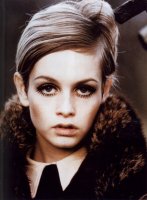 Twiggy from Twiggy in Black and White, published by Simon & Schuster, 1997
Twiggy from Twiggy in Black and White, published by Simon & Schuster, 1997
The fashion extremes of the 1960's (Space age, hippie, mini) paved the way for more realistic and wearable clothes in the 1970's. The U.S. recession and involvement in the Vietnam War helped to bring fashion down to earth and replace fantasy with realism. Blue denim became the uniform of the world. Social changes, particularly the changing roles of women, were echoed with a rise in successful female photographers. Eve Arnold, Deborah Tuberville and Sarah Moon photographed women on their own terms. Not as male sex objects or idolised icons of femininity.
Aesthetic ideals were extended to encompass wider conceptions of beauty. Models such as the Somalian Iman and Hawaiian Marie Helvin rose to prominence. In America the healthy, All-American model look was epitomised by Lauren Hutton and Christie Brinkley.
 Yves Saint Laurent tuxedo by Helmut Newton, 1975. French Vogue
Yves Saint Laurent tuxedo by Helmut Newton, 1975. French Vogue
Some of the strongest images of the decade came from the camera of Berlin born Helmut Newton. Strong, erotic pictures of sexually confident women challenged ideas of femininity and sexual roles. Guy Boudin captured the drug fuelled disco culture with superficially glossy images with subversive, disturbing undertones.
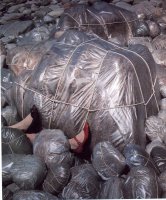 Charles Jourdan shoe by Guy Bourdin, 1987. Samual Bourdin
Charles Jourdan shoe by Guy Bourdin, 1987. Samual Bourdin
Rapid expansion of ready to wear in the 1970's saw the genesis of the catwalk photographer. In previous decades, only a few items from each Haute Couture collection had been made available to photographers. Now, a whole collection could be captured, to feed an ever more voracious public appetite for fashion.
Materialism and hedonism shaped the 1980's. Fashion exploded into a global consumer industry. The advertising industry boomed. Bi-annual designer collection became media events attended by camera and video crews. Fashion photographers played an important role in feeding the global appetite for fashion, glamour and materialism. Beauty ideals continued to change. The Supermodels emerged as icons of physical perfection. But individuality also became an alternative to classical beauty. Pin up boys, championed by Bruce Weber, became the new icons for advertising imagery.
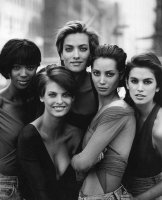 Naomi, Linda,Tatjana,Christy and Cindy by Peter Lindbergh, 1989. Peter lindberg &
British Vogue
Naomi, Linda,Tatjana,Christy and Cindy by Peter Lindbergh, 1989. Peter lindberg &
British Vogue
New wave magazines such as The Face, I-D and Blitz documented the counter culture and provided a breeding ground for new photographers such as Nick knight and Corinne Day. The backlash against 1980's materialism was reflected in the grunge, deconstruction and minimalism of the nineties. Fashion images became more about real life and attitude than the clothes themselves. Skinny, suburban girls modelled street smart clothes. Kate Moss epitomised the dazed and confused waif look. Michael Bracewell of the Guardian commented that “The fashion images of the new youth seem to lack any positivity save that of the junkies gift for self delusion and bombed out apathy.” In May 1997 President Clinton spoke out against the Heroin Chic phenomenon and the industry's vogue for emaciated, spaced out models. Calvin Klein's advertising and the photographs of David Sorrenti outraged but they also reflected some of the realities of youth in the 90's.
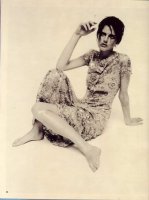 Stella Tennant by Paolo Roversi, 1996. Italian Vogue
Stella Tennant by Paolo Roversi, 1996. Italian Vogue
Gritty realism may have temporarily replaced idealisation in fashion photography but there has been a resurgence of glamour. Haute Couture designs by John Galliano and the late Gianni Versace captured by leading photographers such as Richard Avedon and Steven Meisel celebrate beautiful, extravagant clothes and hark back to a different era.
The 1990's have also seen the growth of digital imagery and manipulation. Photographers such as David La Chapelle and Andrea Giacobbe have used computers and visual art to manipulate pictures and produce surreal fashion imagery.
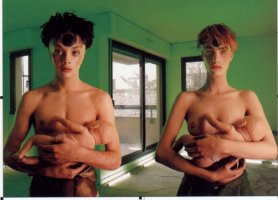 Giocobbe. Andrea Giacobbe 1996. The Face
and Andre Giacobbe
Giocobbe. Andrea Giacobbe 1996. The Face
and Andre Giacobbe
Globalisation and developments in Information Technology mean that trends and fashions are transmitted more quickly. The pace of change in fashion is accelerating. To keep abreast of these changes, photographers on the cutting edge have to quickly assimilate avant-garde trends and appropriate stylistic markers into their work. The most successful not only have a distinctive personal style but are continually in touch with current trends. Because of the key role they play in marketing and advertising, the top fashion photographers have become hugely powerful in the fashion business. Colin McDowell, fashion historian and journalist, comments “It is the fashion photographers who are the real power brokers in the industry, wielding an influence even greater than the top designers”. In an industry driven by publicity, the photographer is king.
What remains constant is that beautiful woman, desirable clothes and talented photographers make a powerful combination.
![]()